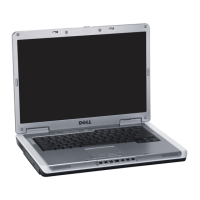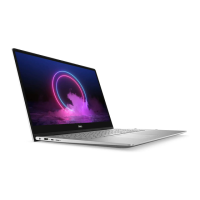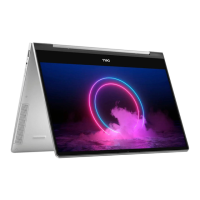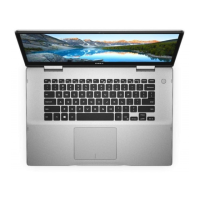Table 2. Advanced Screen Options
I/O Device Configuration Submenu
Table 3. I/O Device Configuration Submenu Options
Security Screen
Select this option and press <Enter> to display the I/O Device Configuration Submenu.
Sets the level-2 (L2) cache to Enabled (the default) or Disabled.
Options are Yes (the default) and No. Set this option to Yes unless your computer is running a non-Microsoft
operating system such as Linux.
Options are DOS (the default) and Other. Set this option to DOS unless your computer is running a non-Microsoft
operating system such as Linux.
Lets you use the <Scroll Lock> key on the external keyboard the same way you use the <Fn> key on the computer's
keyboard. Set this option to Scroll Lock (the default) if you are using an external keyboard. Set this option to
Disabled to disable this function on the external keyboard.
Specifies whether the screen image will appear on the computer display, an attached external monitor, or both.
Options are LCD (the display), CRT (an external monitor), and LCD/CRT. If this option is set to CRT but no
external monitor is connected, the screen image appears on the computer display.
Allows you to switch between Standard and Expanded mode. Under Expanded mode, resolutions other than
800x600expandtofillthescreen.
NOTE: For the full name of an abbreviation or acronym used in this table, see the Glossary in the system Help.
Enabled sets the Serial port A: Base I/O Address to 3F8h IRQ4. If there is a conflict between two or more
addresses, an asterisk appears next to the port type. Disabled disables the serial port to conserve power.
When the option is Enabled, the Mode is Bi-directional, the Base I/O address is 378h IRQ 7. When the option
is set to Disabled, the port is disabled and you can use its assigned LPT resources for another device. If you
change the parallel port address or DMA channel, be careful not to create a conflict with the address.
Configures the integrated local-bus IDE adapter. Options are Both (default), Disabled, Primary, or Secondary. If
Both is selected, you can access both the hard-disk drive and the media bay device(s). If Primary is selected,
only the hard-disk drive is accessible. When Disabled, the media bay device(s) and hard-disk drive are disabled.
Options are Auto (the default) and Disabled. Setting Modem to Auto automatically configures the internal
modem.
Options are Auto (the default) and Disabled. Setting to Auto automatically configures the integrated NIC.
NOTE: For the full name of an abbreviation or acronym used in this table, see the Glossary in the system Help.

